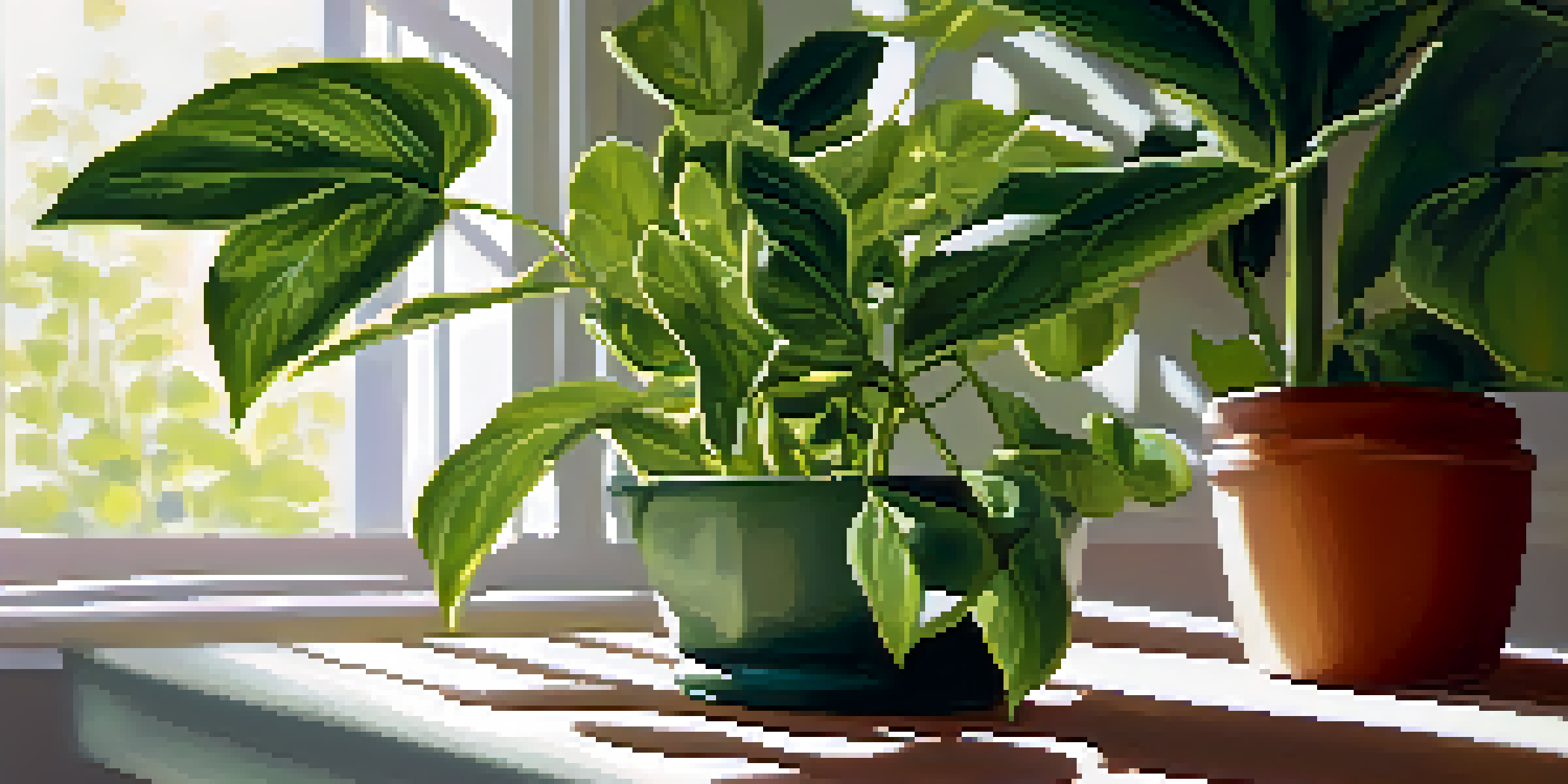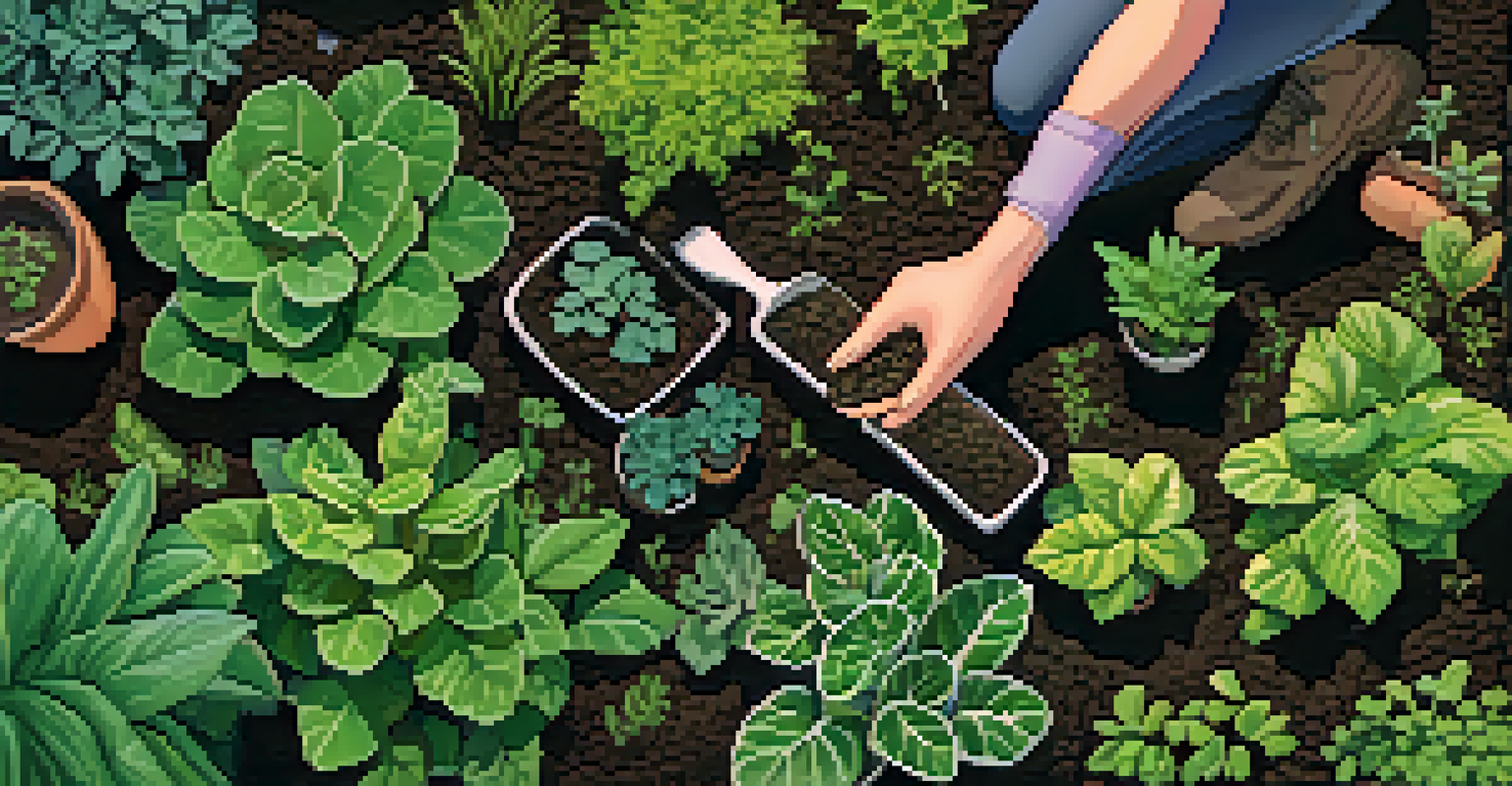Nutrient Deficiencies in Plants: Identification and Remedies

Understanding Nutrient Deficiencies in Plants
Plants require a variety of nutrients to thrive, including macronutrients like nitrogen, phosphorus, and potassium, as well as micronutrients such as iron and manganese. When these essential nutrients are lacking, it can lead to poor growth and overall plant health. Just like humans need a balanced diet, plants also rely on a diverse range of nutrients to flourish.
The love of gardening is a seed once sown that never dies.
Identifying nutrient deficiencies early is crucial, as it can help mitigate damage and promote healthier growth. Symptoms can vary widely among different plants, and understanding what to look for can save you from further complications. Think of it like noticing when a friend is feeling under the weather—you want to catch the signs before it becomes a bigger issue.
Common signs of nutrient deficiencies include yellowing leaves, stunted growth, and poor flowering. By familiarizing yourself with these symptoms, you can become a more observant gardener, ensuring your plants receive the care they need to thrive.
Common Nutrient Deficiencies and Their Symptoms
Nitrogen deficiency is often indicated by yellowing leaves, particularly older leaves, as the plant redirects nutrients to new growth. Phosphorus deficiency can cause dark green or purplish leaves, stunted growth, and poor root development. Potassium deficiency, on the other hand, may present as browning leaf edges and weak stems.

Micronutrient deficiencies can also be tricky. For instance, iron deficiency typically results in yellowing between the veins of younger leaves, while magnesium deficiency can show up as interveinal chlorosis on older leaves. Each nutrient plays a role, and knowing the signs can guide your remediation efforts.
Recognizing Nutrient Deficiencies
Identifying symptoms like yellowing leaves and stunted growth early can help mitigate damage and promote healthier plant growth.
By being attentive to these symptoms, you can better understand what your plant needs. It’s like being a detective—you gather clues, piece them together, and identify the root cause of the problem.
Soil Testing: The First Step in Diagnosis
One of the best ways to identify nutrient deficiencies is through soil testing. This process provides a detailed analysis of soil composition, revealing nutrient levels and pH balance. Think of it as a health check-up for your garden—knowing what’s in your soil can help you tailor your approach to plant care.
To plant a garden is to believe in tomorrow.
Soil tests can be done at home with kits available at garden centers, or you can send samples to a local agricultural extension office for a more comprehensive analysis. This information can help you make informed decisions about fertilization and amendments needed for optimal plant health.
By testing your soil, you can avoid the guesswork and focus on exactly what your plants need. It’s a proactive approach that can save you time, effort, and potentially even your plants' lives.
Choosing the Right Fertilizers for Your Plants
Once you’ve identified a nutrient deficiency, the next step is selecting the right fertilizer. There are two main types: synthetic and organic. Synthetic fertilizers can provide quick results but may also lead to nutrient imbalances if not used carefully, while organic options tend to release nutrients more slowly, promoting long-term health.
Understanding the nutrient content of your chosen fertilizer is crucial. Most fertilizers come with an N-P-K ratio (nitrogen, phosphorus, potassium) on the label, which indicates the proportion of each nutrient. For example, a fertilizer labeled 10-10-10 contains equal parts of all three, while one labeled 5-10-10 is higher in phosphorus, which is beneficial for flowering plants.
Soil Testing is Crucial
Conducting soil tests provides valuable insights into nutrient levels, guiding effective fertilization and plant care.
By selecting the right fertilizer based on your plants’ specific needs, you can effectively remedy deficiencies and support robust growth. It’s about giving your plants exactly what they need to thrive, just like tailoring a diet to meet personal health goals.
Natural Remedies for Nutrient Deficiencies
If you prefer a more natural approach, there are numerous remedies to address nutrient deficiencies. Compost is a fantastic source of organic nutrients and can improve soil structure as well. Adding compost to your garden not only enriches the soil but also helps retain moisture, creating a healthier environment for your plants.
Another option is using natural fertilizers such as bone meal for phosphorus or kelp meal for a broad spectrum of micronutrients. These organic alternatives can gently nourish your plants while promoting long-term soil health. Think of it as feeding your plants a wholesome, home-cooked meal rather than processed fast food.
Incorporating these natural remedies not only helps your plants but also fosters a more sustainable gardening practice. It's a win-win for both your garden and the environment.
Watering Practices Impacting Nutrient Availability
Watering practices play a significant role in nutrient availability for plants. Overwatering can lead to nutrient leaching, where essential nutrients wash away from the root zone, making them unavailable to your plants. Conversely, underwatering can stress plants and hinder their ability to absorb nutrients efficiently.
To maintain a balanced watering routine, consider factors such as soil type, plant species, and weather conditions. For example, sandy soils drain quickly and may require more frequent watering compared to clay soils, which retain moisture longer. Think of it as finding the right balance in your daily hydration—too little or too much can have negative consequences.
Natural Remedies Enhance Soil Health
Using compost and organic fertilizers nourishes plants while promoting sustainable gardening practices.
By adjusting your watering practices, you can help ensure that your plants have access to the nutrients they need. It’s all about creating the right conditions for growth and health.
Monitoring Plant Health for Ongoing Success
Once you’ve addressed nutrient deficiencies, ongoing monitoring is essential for continued plant health. Regularly inspect your plants for any signs of distress or further deficiencies, and keep track of their growth patterns. This proactive approach will help you catch any issues before they escalate.
Consider keeping a gardening journal to document your observations, including watering schedules, fertilization, and any changes in your plants. This can be a valuable resource for understanding what works best for your garden over time. It’s like a personal training log, helping you stay accountable and informed.

By staying vigilant and responsive, you can nurture a thriving garden that yields beautiful, healthy plants. It’s all about being engaged and responsive to the needs of your green companions.